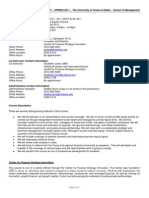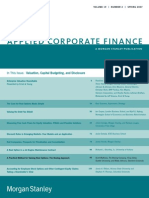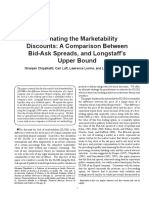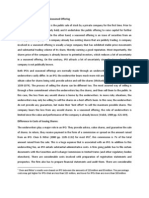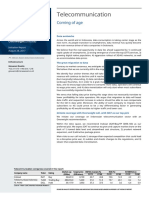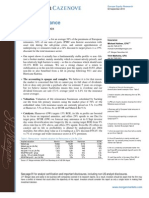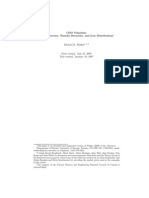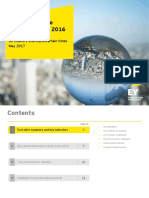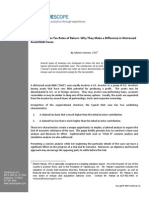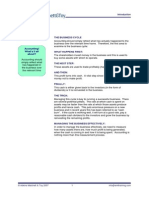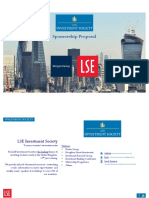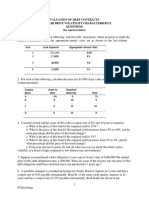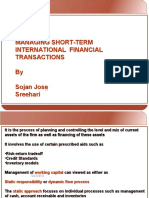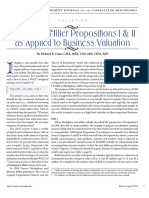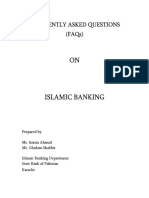Stock Market Liquidity: A Case Study of Karachi Stock Exchange
Stock Market Liquidity: A Case Study of Karachi Stock Exchange
Uploaded by
Bilal AhmadCopyright:
Available Formats
Stock Market Liquidity: A Case Study of Karachi Stock Exchange
Stock Market Liquidity: A Case Study of Karachi Stock Exchange
Uploaded by
Bilal AhmadOriginal Description:
Original Title
Copyright
Available Formats
Share this document
Did you find this document useful?
Is this content inappropriate?
Copyright:
Available Formats
Stock Market Liquidity: A Case Study of Karachi Stock Exchange
Stock Market Liquidity: A Case Study of Karachi Stock Exchange
Uploaded by
Bilal AhmadCopyright:
Available Formats
Pakistan Journal of Commerce and Social Sciences
Vol.3
2009
Stock Market Liquidity: A Case Study of Karachi Stock Exchange
Hakim Ali Kanasro (Corresponding author) Assistant Professor, Institute of Commerce, University of Sindh, Jamshoro, Pakistan. Tel: 92+ 221-772162 Email: hkanasro@hotmail.com
Amanat Ali Jalbani MS and Ph.D. Program Coordinator, SZABIST Karachi Campus, Pakistan. Tel: 92- 21-111-922-478, Email: ajalbani@hotmail.com Mumtaz Ali Junejo Assistant Professor, Department of Commerce, Shah Abdul Latif University of Khairpur, Pakistan. Tel: 92-333-7593655 Abstract A market is to be considered as liquid when large transactions are executed with a small impact on price. This paper identifies the position of stock market liquidity at Karachi Stock Exchange (KSE) during the period from 1985 to 2006. The analysis is based on using annual data of the listed firms at KSE and the data available on economic survey of the Government of Pakistan and other sources. For measurements of liquidity at KSE we have used three measuring tools as; Liquidity Analysis, Turnover Ratio and Size of Market to determine the liquidity issues at KSE. We provide the evidences of less stock market liquidity or to say illiquidity at Karachi Stock Exchange during the sample period. Consequently, market is still for behind in its efficiency, especially in liquidity hence it fails to attract new investors. We find that less liquidity causes less synchronicity in prices attracting less inventors and results is low size of market. Keywords: Stock Market Liquidity, Turnover ratio, Aggregate Market Capitalization, Size of Stock Market, Portfolio investors 1. Introduction Stock markets are playing a crucial role in the capital mobilization and provide secondary markets to the investors and financial institutions to buy and sell the securities. A stock market is to be considered as liquid when large transactions are executed with a small impact on prices of securities. Along with other factors, the stock market liquidity is considered a best tool to measure the efficiency of a stock market. Karachi Stock Exchange (KSE) is one of the oldest security markets of the Pakistan. This research intends to study the liquidity position of KSE through the period 1985 to 2006. The organization of the paper contains review of literature, theoretical framework, data and analysis of liquidity at KSE and finally conclusions with suggestion are given. 2. Review of Literature Stock market liquidity is a slippery and elusive concept partly because it encompasses a number of transactional properties of the market (Kyle 1985). Glen (1994) defines liquidity, as the ability to transact quickly and without substantially moving prices, and market depth as the ability to transact at the current market price. Madhavan (1992) relates the liquidity with information asymmetry and argued that the quality of information possessed by market makers and the traders significantly influence market depth and the size of the bid-ask spread. Thus, higher the information asymmetry, widen the spread, lowering the market depth and market liquidity. Ahn and Chueng, (1999) conclude that Low liquidity is portrayed with a significantly high negative relationship between the spread and market depth. Pagano and Rell (1996) observe that greater transparency in the trading process enhances market liquidity by reducing the opportunities for taking advantage of less informed or nonprofessional participants. Cornell and Sirri (1992) find market liquidity increasing with information asymmetry, as insiders are able to obtain superior execution for their trades relative to the contemporaneous liquidity traders, concluding that the presence of informed traders to the market does not necessarily reduce market liquidity. Email: prof.junejomumtazali@yahoo.com
25
Pakistan Journal of Commerce and Social Sciences
Vol.3
2009
Empirically, the initial level of stock market liquidity is a robust predictor of economic growth and capital accumulation (Levine and Zervos, 1998; Levine, 1997). An extensive microstructure literature on the role of liquidity in price formation process of individual securities is present (Amihud and Medlson 1986. Liquidity co-moves with commonality in liquidity with each security traded in the same market (Hasbrouk and Seppi 2001, Huberman and Halka 2000). In some emerging markets study; liquidity and its implication on asset pricing is important and more acute in emerging markets than developed markets (Bakaert, Harvey and Ludblad 2006). The illiquidity may be more of a concern for investors in emerging markets than those in liquid and developed markets. Empirical literature focusing on the emerging markets looks at the impact of institutional changes on market liquidity, etc (Levine, 1996). Recent performance and its expected variation influence its liquidity by affecting inventory risk of liquidity providers in financial markets or their funding abilities (Copeland and Galai, 1983; Chordia, Roll, and Subrahmanyam 2003; Hameed, Kang and Viswanathan, 2006), co-variation in price and in volatility should also induce a co-variation in the provision of liquidity. Such conjecture motivates the second objective of this paperto investigate what are the possible reasons driving commonality in liquidity. So far there have been several studies documenting the existence of commonality in U.S. (Chordia, Roll and Subrahmanyam, 2002; Hasbrouck and Seppi, 2001; and Huberman and Halka, 2001), Hong Kong (Brockman and Chung, 2002) and Austrian security markets (Sujoto, Kalev and Faff, 2005). But none of them looks at the reasons why such phenomenon exists. Coughenour and Saad (2004) document the co-variation in liquidity among securities handed by the same specialist firm. They believe that shared capital and information among specialists within a firm cause co-movement in their provision of liquidity. Hameed, Kang and Viswanathan (2006) suggest that market states can affect the funding ability of financial intermediaries, and thus inducing the co-variation in their provision of liquidities. Their research extends this stream of research further. First, they investigate another candidate factor that could induce marketwide co-movement in liquidity in emerging marketsmarket uncertainty. If, as they discussed above, covariation in price and in volatility could induce co-variation in the provision of liquidity, they see that the market uncertainty is another driving force of intra-market commonality. And this effect should be weaker in developed markets, where security prices do not co-move much with each other. They empirically test this conjecture by looking at the impact of market uncertainty on the time series variation of individual securities. And thy also compare this effect with that from developed market to see if there is a difference. Second, Morck et al. (2000) attribute the high synchronicity of returns in emerging markets to the poor property rights protection which deter risk arbitrage, cause more noise trading and thus causing more market-wide stock price variation. If this is also the underlying reason for commonality in liquidity in emerging markets, we shall see a link between the country governance or market development and intra-market co-variation in liquidity. Emerging markets do have some macro economic features that could induce higher commonality in liquidity. For example, emerging markets usually do not have many alternative investments (for example, bonds). Or even if they have, the markets may not be well developed. As a result, investors facing liquidation needs cannot easily diversify their liquidity shock among several asset classes, thus causing the co-variation in liquidity in one asset market. Therefore, beyond studying at the individual security level, we also investigate the impact of some market or country features on intra-market commonality in liquidity. Third, it has been well acknowledged that liberalization of emerging markets and international fund flows have reduced cost of capital and increased liquidity of these markets (Bekaert and Harvey, 2000 Lesmond, 2005). However, how does the liberalization process affect the risk of liquidity is still unknown. If international fund flows also reduce the commonality in liquidity, there should not be any problem. However, if they cause more commonality, which increases the liquidity risk in emerging markets, it would become a concern for both investors and regulators. Therefore, an investigation into the impact of international fund flow on the market liquidity risk is both necessary and valuable. 3. Theoretical Framework A stock market is liquid when a large transaction take place without affecting prices of securities or a stock is illiquid when sell orders are filled with lower price than buy orders. So; stock markets are trapped in a low liquidity high risk premium equilibrium (Pagano, 1993). Investors have fewer opportunities to diversify their portfolios are at high risk. Less opportunities of diversification cause a panic amongst the investors and they start to fill lower price sell orders then stock market investors start to bear losses. There are so many causes of illiquidity. But, question that how to measure the liquidity or illiquidity and what are the tools to be used for such measurements, we gone through the literature and find that there is no any single tool through which one can directly measure the stock markets liquidity, instead we found that there are some indirect or proxy tools have been used to measure the liquidity of individual stock, individual market, cross-listed firms or commonality in liquidity across the market (Zheng, 2006)
26
Pakistan Journal of Commerce and Social Sciences
4. Data
Vol.3
2009
We focus on the conventional data sources over the entire sample period are: Economic Surveys being published by the Government of Pakistan, Statistical Reports by State Bank of Pakistan, Analysis of Listed Companies at Karachi Stock Exchange published by State Bank of Pakistan and Data from Annual Reports of KSE over the entire sample period. The data has been filtered and for the purpose of liquidity measurements as Total Value of Shares Traded with GDP only year wise data of these two components has been used. The measurement of Turnover is based on the Yearly wise data of two components viz.: Yearly data of market capitalization and Value of total shares traded during the sample period. The yearly observation is on over the period of 21 years that is 1985-86-2005-06. However a monthly data on the turnover was available from the month of July 1996 to the June 2003 which is separately analyzed and that is depicted as graph-6. 4.1 Stock Market Liquidity at KSE The stability of market is determined through liquidity of its securities, which means that how these securities are easily bought or sold in the market. The liquidity in one way enables the markets to improve the allocation of capital and enhance prospects of long-term growth. These indicators complement the market capitalization ratio by showing whether market size is large or small. Here, three methods are used to measure the liquidity in our analysis viz.: Method 1: In this method the Total Value of Traded Securities (TVTS) is divided with the GDP and multiplied with the hundred to determine the product as percentage of GDP, which measures the organized trading of equities as a share of national output and should therefore, reflect liquidity on an economy-wide basis. Liquidity =Total Value of Traded Securities/ Gross Domestic Product (GDP) (Liquidity means Liquidity at KSE during the sample period, Total Value of Traded Securities at Karachi Stock Exchange during the Sample Period, Gross Domestic Product means annual GDP at Factor Cost of country Pakistan during the sample period) Method 2: The second method to measure the liquidity is with the use of Turnover Ratio. Turnover equals the value of total shares traded divided by market capitalization. High turnover is often used as an indicator of low transaction costs. Value of Shares Traded: Turnover = Aggregate Market Capitalization (Turnover means Turnover at KSE during the sample period, Value of Shares Traded equals to Value of Shares Traded at KSE during the sample period, Aggregate Market Capitalization stands for Aggregate Market Capitalization at KSE during the sample period) Method-3: This method complements the second method of turnover ratio as it encompasses the structural reforms of capital market and governments liberalization policies adjustments which are visible through the comparison or determining of the ratio of stock market size and economic growth. Market Size= Gross Domestic Product/ Aggregate Market Capitalization (Market Size stands for Market Size of KSE during the sample period, Gross Domestic Product means annual GDP at Factor Cost of country Pakistan during the sample period and Aggregate Market Capitalization stands for Aggregate Market Capitalization at Karachi Stock Exchange during the sample period) Therefore, these three measures have been used to determine the market liquidity of Karachi stock exchange in detail given as bellow: 5. Analysis of Liquidity at KSE Method 1: Liquidity as Percentage of GDP The analysis of total value traded as percentage of GDP for determining of the liquidity of market is given in the table-1. The analysis reveals that the liquidity was less than one percent of the GDP till the year 2002-03. It, however improved significantly and in the year 2003-04 it reached at 1.15 of GDP. Table-1 also reveals that the ratio of liquidity at KSE increased and significantly rose to 1.56 of GDP in the year 2004-05. The liquidity increased during the study year 2005-06 as 1.78 of GDP and it was at high and first time it reached at that point. The change in the liquidity as total value of total shares traded as of GDP given in the table-1 is also significant. The study reveals that during the period from 1994-95 and onward it moved up and sharply increase has been witnessed after 1996-97 to 2006. The same is depicted in the graph -1.
27
Pakistan Journal of Commerce and Social Sciences
Graph-1
Vol.3
2009
1 0000 9000 8000 7000 6000 5000 4000 3000 2000 1 000 0
VALUE OF TOTAL SHARES TRADED AT KSE AND GDP OF PAKISTAN
Value of Tot al Shar es Tr aded ( Rs.Billion) GDP ( f c) Rs. Billion
This reveals that the market is unpredcitable in the forecasting of when we look at its trends of liquidity. Though, it has been increased but not constantly that means it changed rapidily up to the year 1999-2000. The given statistics and its analysis has been also dipicted in the Graph-1 given above. Although, the first ten years of our study period showed a slight increase in both the GDP and value of total shares traded at KSE, but there a significant jumps in the liquidity (total value of shares traded to GDP) in last six years (see Graph-2). The overall average liquidity during sample period remained 0.64 which is low than 1. This situation needs more attention towards the issue of liquidity to be studied in detail to know whether there are fundamental changes occurred which changed the whole scenario in last six years or there is something extraordinary in the market? Whether it is market efficiency or an other game of big players in the market? Infact, on economic political front there are so many scandals have been unfold during this period. Business at KSE is also has remained under the flushes of these scandalous news and big wigs of the governemnet as a major players of these scandals. In such conditions the short and medium term investors are skeptic towards the markets efficiency and they perfer to be away from the game of investment. Graph - 2
2.00 1.80 1.60 1.40 1.20 1.00 0.80 0.60 0.40 0.20 0.00
19 85 1 9 -86 86 1 9 -87 87 1 9 -88 88 1 9 -89 89 1 9 -90 90 1 9 -91 91 1 9 -92 92 1 9 -93 93 1 9 -94 94 1 9 -95 95 1 9 -96 96 1 9 -97 97 1 9 -98 98 1 9 -99 99 2 0 -00 00 2 0 -01 01 2 0 -02 02 2 0 -03 03 2 0 -04 04 2 0 -05 05 -0 6
1985-86 1986-87 1987-88 1988-89 1989-90 1990-91 1991-92 1992-93 1993-94 1994-95 1995-96 1996-97 1997-98 1998-99 1999-00 2000-01 2001-02 2002-03 2003-04 2004-05 2005-06
Liquidity at KSE
Liquidity at KSE
28
Pakistan Journal of Commerce and Social Sciences
Method 2: Liquidity by Turnover Ratio
Vol.3
2009
The turnover position of the Karachi stock exchange has been only 0.10 of the Aggregate Market Capitalization (AMC) in the year 1986-87, which lowered at 0.09 with -14.22 percent in the year 1986-87, and again lowered at 0.08 which is -6.69 percent decrease over the previous year. The turnover ratio witnessed upward trend but in terms of percentage change over the year 1990-91 a sharp decline of 98.89% in the year 1991-92 has been noticed. The turnover has witnessed an increase during the study period from 1990-91 to 1996-97 as less than 1 or say the ratio was 1:0.98 in the year 1996-97. As revealed in the Table-2, the turnover ratio sharply increased to 1.64 of Market Capitalization in the year 1997-98, or with the tremendous change of 39.28 percent over the year 1996-97. The percentage change during the study period has witnessed sharp upward and downward trend from the period 1994-95 to 1998-99 and 1999-00. But after this period a sharp incline has been witnessed during the year2000-01. In commencing year a sharp decline and again a sharp incline in the turnover at KSE (see Graph-3 and Graph-4). Following the same trends; the market some how maintained its turnover position during the years 2003-2004, 2004-2005 and 2005-2006 respectively. The average Turnover ration of KSE has been remained 1.57 during the sample period. Graph 3
Turnover Ratio
Turnover Ratio 6.00 5.00 4.00 3.00 2.00 1.00 0.00
19 85 19 -86 86 19 -87 87 19 -88 88 19 -89 89 19 -90 90 19 -91 91 19 -92 92 19 -93 93 19 -94 94 19 -95 95 19 -96 96 19 -97 97 19 -98 19 98 99 -99 -2 0 20 0 0 00 20 -01 01 20 -02 02 20 -03 03 20 -04 04 20 -05 05 -0 6
This whole study reveals that after the 1994-95 the following years has seen a tremendous increase in the turnover. It accelerated and reached to 3.78 turnover ratios in the year 1998-99 after slight trends of inclination (see Table-2). Graph - 4
Annual Percentage Change in Turnover % Change (-) (+) 100.0
50.0
0.0
19 85 19 -86 86 19 -87 87 19 -88 88 19 -89 89 19 -90 90 19 -91 91 19 -92 92 19 -93 93 19 -94 94 19 -95 95 19 -96 96 19 -97 97 19 -98 19 98 99 -99 -2 0 20 0 0 00 20 -01 01 20 -02 02 20 -03 03 20 -04 04 20 -05 05 -0 6
-50.0
-100.0
-150.0
-200.0
29
Pakistan Journal of Commerce and Social Sciences
Vol.3
2009
But, when percentage wise change has been studied it is showing a zigzag position in its trends during the study period from 1987-88 to 2005-06. It is obvious to note that the turnover ratio remained constant from1992-93 to 1998-99 with slight ups and down but it gone its maximum and minimum points during the period from 1998-99 to 2003-2004 and even in negative during the period 2003-04 to 2005-06 (see Graph 4 and Graph-6) Graph-5
Size of Market (KSE)
70.00 60.00 50.00 40.00 30.00 20.00 10.00 0.00
19 8 19 5-8 86 6 19 -8 8 7 19 7-8 88 8 19 -8 8 9 19 9-9 90 0 19 -9 9 1 19 1-9 9 2 19 2-9 9 3 19 3-9 94 4 19 -9 9 5 19 5-9 9 6 19 6-9 97 7 1 19 99 98 99 8-9 -2 9 20 000 0 20 0-0 01 1 20 -0 0 2 20 2-0 03 3 20 -0 0 4 20 4-0 05 5 -0 6
Method-3: The Size of Karachi Stock Exchange This study is to determine the size of the KSE with two components viz; Aggregate Market Capitalization as the ratio of Gross Domestic Product of the country Pakistan during the sample period. The results are given in Table-3 and Graph-5. According to our study the size of KSE remained very low from the year 1985-86 to 1990-1991. The overall average size of the market has remained only 22.90 percent of GDP which is still very low in comparison of this with other emerging markets of the world. (Note: For short of space here we do not give any comparison) But after the structural and developments policies like emergence of a number of countries including Pakistan in the capital market during this period, four main ideas have dominated its development. First, the privatization of public sector units gave a boost to the capital market especially in Mexico, Malaysia, Pakistan, Philippine and India. Second, the capital market was opened to foreign investors through its internationalization and hence it encouraged the foreigners to make direct investment in a number of south Asian countries. Third, due to the fall of Soviet Union and some other socialist countries, the command economies were transforming into the capitalist system. Along with other changes, the transformation also led to the emergence of new capital markets even in china, Vietnam and Mongolia, the citadels of the socialist system. Finally, the tremendous increase in the services for trading, settlement and depositing system and the introduction of automation and computerization of stock exchanges accelerated the emergence of capital market (Mian Mumtaz Abdulah 2003). Thus, the study suggests that the first five and second five years of study period KSE have witnessed very low liquidity and it was even less than 0.1 during 1985-86 to 1989-90. But due to some policy changes (as mentioned above) and liberal changes in the institutional setup and some improvement in the access to information, the market liquidity has been improved systematically.
30
Pakistan Journal of Commerce and Social Sciences
Graph-6
Turnove r at KSE
Vol.3
2009
10 0 0 0 9000
Million nos Shares.
8000 70 0 0 6000 50 0 0 4000 3000 2000 10 0 0 0
Monthly data
6. Conclusion The above used all measurements are proxy or indirect measurements of liquidity in a stock excahnge and results therefore are mostly on ratios concerning with GDP and Aggregate Market Capitalization as the denonimators on the value of total share traded as numerator in first two measures; but the third mearuement to detrmine the size is the ratio between the GDP and Aggregate Market Capitalization. The liquidity at KSE has been witnessed a dormant situation during the first five years of the study. It has been moving upoward from the year 1990-91 to 1995-96 and again a zigzag trends say moving upward and downward in its liquidity from the year 1996-97 to 1999-00 has been seen. But after 2001-2002 it has tremendously gone to its high peaks as witnessed in this study. This reveals that the market was unpredcitable in the forecasting of its liquidity during the study years from 1985-86 to 1999-00. The sharp inclining and declining trends in its liquidity and turnover during the third period from year 1995-96 to 1999-00 suggested that the market was totally unpredictable and it restricted the short medium and long-term investment, because low and unpredictable liquidity or more appropriately said illiquidity. The last spell of study period from the year 2001-2002 onward has been a sharp upward trend which may causes a removal of fear of loss amongst the long term investors and portfolio investors. Through the above study wee provide the evidences of less stock market liquidity or to say illiquidity at KSE during the sample period. Consequently, market is still for behind in its efficiency, especially in liquidity hence it fails to attract new investors. We find that less liquidity causes less synchronicity in prices attracting less inventors and results is low size of market. References Ahn, H.J. and Cheng, Y. (1999).The intra day patterns of spreads and depth in a market without market makers. The stock exchange of Hong Kong. Pacific-Basin Finance Journal, 17, 539-556. Amihud, Y., and H. Mendelson, 1986, Asset Pricing and the bid-ask spread, Journal of Financial Economics 17, 223-249. Annual Reports of State Bank of Pakistan (Various issues) Bekaert, G., and Harvey, C. R. (2000). Foreign speculators and emerging equity markets, Journal of Finance. 55, 565-614. Bekaert, G., Harvey, C. R. and Lundblad, C. (2006). Liquidity and expected returns: Lessons from emerging markets. Working paper. Brockman, P., and Chung, D. Y. (2002). Commonality in liquidity: Evidence from an order driven market structure, Journal of Financial Research, 25, 521-539. Chordia, T., R. Roll, and Subrahmanyam, A. (2000). Commonality in liquidity, Journal of Financial Economics, 56, 3-28.
31
Pakistan Journal of Commerce and Social Sciences
Vol.3
2009
Chordia, T., R. Roll, and Subrahmanyam, A. (2003). Determinants of daily fluctuations in liquidity and trading activity. Working paper. Copeland, T. E., and Galai, D. (1983). Informational effects on the bid ask spread, Journal of Finance, 38, 1457-1469. Cornell, B. and Sirri, E.R. (1992). The reaction of investors and stock prices to insider trading. Journal of Finance, 47, 1031-1059. Coughenour, J. F., and Saad, M. M. (2004). Common market makers and commonality in liquidity, Journal of Financial economics, 73, 37-69. Eun, C., and Shim, S. (1989). International transmission of stock market movements, Journal of Financial and Quantitative Analysis, 24, 24156. Fujimoto, A. (2004). Macroeconomic sources of systematic liquidity, Working paper, Yale University Glen, J. (1994) An introduction to the microstructure of emerging markets. International Finance corporation Discussion Paper No. 2 Washington D.C. IFC. Hameed, A., Kang, W. and Viswanathan, S. (2006). Stock market decline and liquidity, Working paper. Hasbrouck, J., and Seppi, D. J. (2001). Common factors in prices order flows, and liquidity, Journal of Financial Economics, 59, 383-411, Huberman, G., and Halka, D. (2001). Systematic liquidity, Journal of Financial Research, 24, 161-178. Kyle, A.S. (1985) Continuous auctions and insider trading. Econometrica, 53(6), 1315-1335. Lesmond, D. (2005). Liquidity of emerging markets, Journal of Financial Economics, 77, 411-452. Levine, R., Zervos, S. (1996). Stock market development and long run growth. World Bank Economic Review, 10, 323-39 Levine, R. (1997). Financial development and growth: Views and agenda. Journal of Economic Literature, 35, 688-726. Levine, R., Zervos, S. (1998). Stock markets, banks, and economic growth. American Economic Review, 88 (3), 537-558. Madhavan, A. (1992). Trading mechanisms in securities markets. Journal of Finance, XLVII (2), 607-641. Morck R., Yeung, B. and Yu, W. (2000). The information content of stock market: why do emerging markets have synchronous stock price movements? Journal of Financial Economics, 58, 215-260. Abdullah, M.M. (2003). Paper presented at seminar [online] Available: http/ www.ise.com.pk (19-08-2008). Pagano, M. and Rell, A. (1996). Transparency and liquidity. A comparison of auction and dealer markets with informed trading. Journal of Finance LI (2), 579-611. Pakistan Economic Survey. Government of Pakistan, Ministry of Finance Islamabad (Various Issues) Zheng, Xinwei and Zhang (2006). Zhichao,Commonality in Liquidity in Emerging Markets: Evidence from the Chinese Stock Market. Durham Working Paper in Economics and Finance No. 06/04. [online] Available SSRN: http://ssrn.com/abstract=940613 (October 2006).
32
Pakistan Journal of Commerce and Social Sciences
Table-1 LIQUIDITY AT KARACHI STOCK EXCHANGE
Year 1985-86 1986-87 1987-88 1988-89 1989-90 1990-91 1991-92 1992-93 1993-94 1994-95 1995-96 1996-97 1997-98 1998-99 1999-00 2000-01 2001-02 2002-03 2003-04 2004-05 2005-06 Total Average Value of Total Shares Traded (Rs.Billion) 2.583 2.813 3.181 3.91 4.979 15.232 24.435 51.579 97.472 101.446 218.21 461.611 424.675 1081.143 605.6 1877.8 805.6 3841 4862 7167.58 8707.46 30360.31 1445.73 GDP (fc)* Rs. Billion 466.319 515.431 601.025 683.138 759.854 908.374 1077.943 1200.129 1412.858 1688.126 1951.56 2255.649 2480.884 2711.078 3,562.02 3,632.09 3,745.12 3,922.10 4,215.61 4,593.23 4,896.74 47279.27 2251.39 Liquidity 0.01 0.01 0.01 0.01 0.01 0.02 0.02 0.04 0.07 0.06 0.11 0.20 0.17 0.40 0.17 0.52 0.22 0.98 1.15 1.56 1.78 0.64 0.64
Vol.3
2009
Sources: IFC Emerging Market Data Base (Various Issues) SBP Annual Report and Economic survey (Various Issues) Table- 2 TURNOVER RATIO
Year Value of Total Shares Aggregate Market Capitalization Turnover Traded (Rs. Billion) (A/B) (Rs.Billion) B A 2.583 2.813 3.181 3.91 4.979 15.232 24.435 51.579 97.472 101.446 218.21 461.611 424.675 1081.143 25.42 31.62 38.15 43.93 48.63 68.44 218.36 214.43 404.58 293.33 365.24 469.15 259.3 286.2 0.10 0.09 0.08 0.09 0.10 0.22 0.11 0.24 0.24 0.35 0.60 0.98 1.64 3.78 Annual Change in % (-) (+) of Turnover Ratio 0.00 -14.22 -6.69 6.32 13.07 54.00 -98.89 53.48 0.16 30.34 42.11 39.28 39.92 56.64
1985-86 1986-87 1987-88 1988-89 1989-90 1990-91 1991-92 1992-93 1993-94 1994-95 1995-96 1996-97 1997-98 1998-99
33
Pakistan Journal of Commerce and Social Sciences
1999-00 2000-01 2001-02 2002-03 2003-04 2004-05 2005-06 Total Average 605.6 1877.8 805.6 3841 4862 7167.58 8707.46 30360.31 1445.73 391.86 339.249 407.637 748.434 1357.5 2013.2 2801 10825.66 515.50762 1.55 5.54 1.98 5.13 3.58 3.56 3.11 33.06 1.57 -144.43 72.08 -180.08 61.49 -43.29 -0.60 -14.53
Vol.3
2009
Source: Government of Pakistan, Finance Division, Economic Advisers Wing, Islamabad, Economic survey (Various Issues), Annual Reports of SBP (Various Issues) Table-3 SIZE OF KARACHI STOCK EXCHANGE
GDP (fc) Rs Billion 466.319 515.431 601.025 683.138 759.854 908.374 1077.943 1200.129 1412.858 1688.126 1951.56 2255.649 2480.884 2711.078 3,562.02 3,632.09 3,745.12 3,922.10 4,215.61 4,593.23 4,896.74 47279.27 2251.39 Aggregate Market Capitalization (AMC) (Rs. Billion) 25.42 31.62 38.15 43.93 48.63 68.44 218.36 214.43 404.58 293.33 365.24 469.15 259.3 286.2 391.86 339.249 407.637 748.434 1357.5 2013.2 2801 10825.66 515.50762 Size of Market (KSE) 5.45 6.13 6.35 6.43 6.40 7.53 20.26 17.87 28.64 17.38 18.72 20.80 10.45 10.56 11.00 9.34 10.88 19.08 32.20 43.83 57.20 22.90 22.90
Year 1985-86 1986-87 1987-88 1988-89 1989-90 1990-91 1991-92 1992-93 1993-94 1994-95 1995-96 1996-97 1997-98 1998-99 1999-00 2000-01 2001-02 2002-03 2003-04 2004-05 2005-06 Total Average
Source: Government of Pakistan, Finance Division, Economic Advisers Wing, Islamabad, Economic survey (Various Issues), Annual Reports of SBP (Various Issues)
34
You might also like
- Foundational Theories and Techniques for Risk Management, A Guide for Professional Risk Managers in Financial Services - Part II - Financial InstrumentsFrom EverandFoundational Theories and Techniques for Risk Management, A Guide for Professional Risk Managers in Financial Services - Part II - Financial InstrumentsNo ratings yet
- Dual Excess Earnings WhitepaperDocument26 pagesDual Excess Earnings WhitepaperBruno BardelliniNo ratings yet
- Valuing Using Industry MultiplesDocument11 pagesValuing Using Industry MultiplesSabina BuzoiNo ratings yet
- PAR Investor Letter 6.9.2020Document5 pagesPAR Investor Letter 6.9.2020Jordan ThaelerNo ratings yet
- 02 Oct 2013 Fact SheetDocument1 page02 Oct 2013 Fact SheetfaisaladeemNo ratings yet
- DistressDocument49 pagesDistressОксана Пелипец100% (1)
- A Look Back at Modern Finance Accomplishments and LimitationsDocument8 pagesA Look Back at Modern Finance Accomplishments and LimitationsNikhil VidhaniNo ratings yet
- USS Global Equity Fund FactsheetDocument1 pageUSS Global Equity Fund Factsheetsteven burnsNo ratings yet
- Sta 630 Research Methods Solved MCQ SDocument21 pagesSta 630 Research Methods Solved MCQ SBilal Ahmad86% (7)
- Case UcpDocument1 pageCase UcpBilal AhmadNo ratings yet
- Business Communication in Global ContextDocument14 pagesBusiness Communication in Global ContextBilal Ahmad100% (1)
- IFR Definitive GuideDocument257 pagesIFR Definitive Guidehussaisz100% (1)
- SSRN Id3550293 PDFDocument143 pagesSSRN Id3550293 PDFKojiro Fuuma100% (1)
- 13 Introduction To Insurance Financial StatementsDocument1 page13 Introduction To Insurance Financial StatementsOladipupo Mayowa PaulNo ratings yet
- Sustainability of Govt DebtDocument8 pagesSustainability of Govt DebtSpencer RascoffNo ratings yet
- Technical Analysis of The Size PremiumDocument4 pagesTechnical Analysis of The Size PremiumRamiro Gamen0% (1)
- Estimating The Cost of Risky Debt by Ian CooperDocument8 pagesEstimating The Cost of Risky Debt by Ian CooperAntonio EmmeNo ratings yet
- UT Dallas Syllabus For Fin6316.001.11s Taught by David Springate (Spring8)Document7 pagesUT Dallas Syllabus For Fin6316.001.11s Taught by David Springate (Spring8)UT Dallas Provost's Technology GroupNo ratings yet
- The Common Determinants of Merger and Acquisition SuccessDocument16 pagesThe Common Determinants of Merger and Acquisition SuccessSi QinNo ratings yet
- Datar MathewsDocument12 pagesDatar MathewsLukito Adi NugrohoNo ratings yet
- Allowance For Risk in Market Consistent Embedded Value (MCEV)Document12 pagesAllowance For Risk in Market Consistent Embedded Value (MCEV)apluNo ratings yet
- Estimating The Marketability Discounts: A Comparison Between Bid-Ask Spreads, and Longstaff's Upper BoundDocument14 pagesEstimating The Marketability Discounts: A Comparison Between Bid-Ask Spreads, and Longstaff's Upper BoundBrexa ManagementNo ratings yet
- UT Dallas Syllabus For Entp6316.5u1.11u Taught by David Springate (Spring8)Document7 pagesUT Dallas Syllabus For Entp6316.5u1.11u Taught by David Springate (Spring8)UT Dallas Provost's Technology GroupNo ratings yet
- Fabozzi Gupta MarDocument16 pagesFabozzi Gupta MarFernanda RodriguesNo ratings yet
- q2 Valuation Insights Second 2020 PDFDocument20 pagesq2 Valuation Insights Second 2020 PDFKojiro FuumaNo ratings yet
- Ec1723 Syllabus Sept4 2018-1Document11 pagesEc1723 Syllabus Sept4 2018-1auctmetuNo ratings yet
- IPO AssignmentDocument3 pagesIPO AssignmentBadr IftikharNo ratings yet
- PT. Mirae Asset Sekuritas Indonesia - Initiation Report PDFDocument75 pagesPT. Mirae Asset Sekuritas Indonesia - Initiation Report PDFLia HafizaNo ratings yet
- Performance Evaluation of Mutual Funds in Pakistan For The Period 2004-2008Document13 pagesPerformance Evaluation of Mutual Funds in Pakistan For The Period 2004-2008Mustafa ShabbarNo ratings yet
- BPI Global Equity Fund of Funds - September 2023 v2Document4 pagesBPI Global Equity Fund of Funds - September 2023 v2Ramon VinzonNo ratings yet
- European Re InsuranceDocument95 pagesEuropean Re InsuranceKapil MehtaNo ratings yet
- CDO Valuation: Term Structure, Tranche Structure, and Loss DistributionsDocument26 pagesCDO Valuation: Term Structure, Tranche Structure, and Loss DistributionsSimran AroraNo ratings yet
- Maximizing The Value of Distressed Assets - Bankruptcy Law and The Efficient Reorganization of FirmsDocument48 pagesMaximizing The Value of Distressed Assets - Bankruptcy Law and The Efficient Reorganization of Firmsvidovdan9852No ratings yet
- Global Insurance Trends Analysis 2016Document29 pagesGlobal Insurance Trends Analysis 2016Rahul MandalNo ratings yet
- Ohlson 2007Document10 pagesOhlson 2007mzurzdcoNo ratings yet
- Moody S Corporate Default and Recovery Rates 1920 2010 Moody S February 2011 PDFDocument66 pagesMoody S Corporate Default and Recovery Rates 1920 2010 Moody S February 2011 PDFDintyMoNo ratings yet
- Asias Future Is Now FinalDocument20 pagesAsias Future Is Now FinalPatricia GarciaNo ratings yet
- Cfa Mnemonic S Level 1 Sample PDFDocument19 pagesCfa Mnemonic S Level 1 Sample PDFSohail Merchant100% (1)
- Variable Interest 2013Document246 pagesVariable Interest 2013gligorjan100% (1)
- Pretax and After-Tax Rates of Return - DAD CasesDocument7 pagesPretax and After-Tax Rates of Return - DAD Casesvalue4321No ratings yet
- Eri WP Predicting Decomposing Risk Data Driven Portfolios 0 PDFDocument46 pagesEri WP Predicting Decomposing Risk Data Driven Portfolios 0 PDFdemetraNo ratings yet
- Bank Concentration, Competition, and Crises First ResultsDocument23 pagesBank Concentration, Competition, and Crises First ResultsManuela CarreiraNo ratings yet
- Operating ExposureDocument31 pagesOperating ExposureMai LiênNo ratings yet
- IBD Technical Interview Prep - 10nov15Document1 pageIBD Technical Interview Prep - 10nov15PogotoshNo ratings yet
- 2012.08.21 - The Importance of Expectations - That Question That Bears Repeating - What's Priced in PDFDocument17 pages2012.08.21 - The Importance of Expectations - That Question That Bears Repeating - What's Priced in PDFbrineshrimpNo ratings yet
- Corporate Debt Structure - Full Paper PDFDocument69 pagesCorporate Debt Structure - Full Paper PDFQuan Quỷ QuyệtNo ratings yet
- Accounting! What's It All About?: THE Business CycleDocument10 pagesAccounting! What's It All About?: THE Business CycleMarcinNo ratings yet
- On Buy Back of ShareDocument30 pagesOn Buy Back of Shareranjay260No ratings yet
- BAFI507 FT2017 Syllabus PikulinaDocument10 pagesBAFI507 FT2017 Syllabus Pikulinauygh g100% (1)
- PitchbookDocument15 pagesPitchbookAnonymous DTIFVdNo ratings yet
- Valuation of Debt Contracts and Their Price Volatility Characteristics Questions See Answers BelowDocument7 pagesValuation of Debt Contracts and Their Price Volatility Characteristics Questions See Answers Belowevivanco1899No ratings yet
- Lecture 4 - ReformattingDocument31 pagesLecture 4 - ReformattingnopeNo ratings yet
- Limited Risk Models - Sept 4 2013Document40 pagesLimited Risk Models - Sept 4 2013sriramrangaNo ratings yet
- Chapter 23 Sojan & SreehariDocument19 pagesChapter 23 Sojan & SreehariSojanuNo ratings yet
- PWC Ifrs Ifrs9 New Way Hedging StrategiesDocument2 pagesPWC Ifrs Ifrs9 New Way Hedging StrategiesfabiopnoronhaNo ratings yet
- MBA 406 Syllabus Fall 2011Document13 pagesMBA 406 Syllabus Fall 2011Syed Fahad AhmedNo ratings yet
- Modelling Cost at Risk - A Preliminary Approach - 0Document16 pagesModelling Cost at Risk - A Preliminary Approach - 0Uzair Ul HaqNo ratings yet
- Modigliani Miller Prop 1 and 2 PDFDocument8 pagesModigliani Miller Prop 1 and 2 PDFChittisa CharoenpanichNo ratings yet
- EV and VNB MethodologyDocument2 pagesEV and VNB MethodologySaravanan BalakrishnanNo ratings yet
- Portfolio ConstructionDocument15 pagesPortfolio ConstructionParul GuptaNo ratings yet
- Brian Arthur - Increasing Returns and The New World of BusinessDocument11 pagesBrian Arthur - Increasing Returns and The New World of BusinessLuis Gonzalo Trigo SotoNo ratings yet
- SNL Fundamentals of Peer AnalysisDocument44 pagesSNL Fundamentals of Peer AnalysisBilal AhmadNo ratings yet
- Job TurnoverDocument12 pagesJob TurnoverBilal AhmadNo ratings yet
- Banking Software and SelectionDocument16 pagesBanking Software and SelectionBilal AhmadNo ratings yet
- Islamic Banking FAQs EnglishDocument55 pagesIslamic Banking FAQs EnglishBilal AhmadNo ratings yet
- HayesDocument36 pagesHayesBilal AhmadNo ratings yet
- GMAT Exam SuccessDocument416 pagesGMAT Exam Successkedari007100% (2)
- Letter of Credit ProjectDocument42 pagesLetter of Credit ProjectBilal AhmadNo ratings yet
- Accounting Chapter 3 William HakaDocument6 pagesAccounting Chapter 3 William HakaBilal AhmadNo ratings yet
- Corporate Social ResponsibilitiesDocument14 pagesCorporate Social ResponsibilitiesBilal AhmadNo ratings yet
- Faysal BankDocument42 pagesFaysal BankBilal Ahmad100% (3)

















